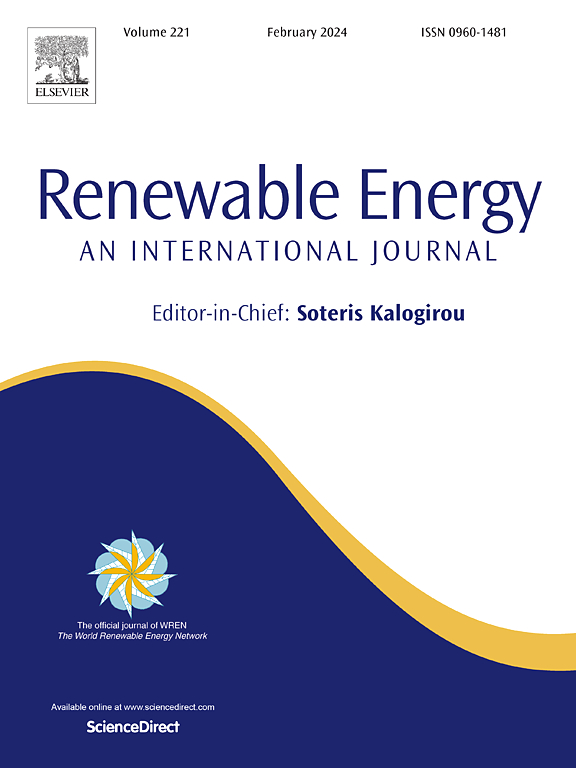具有移动氢运输功能的多集成能源系统的电氢共享储能优化配置
IF 9
1区 工程技术
Q1 ENERGY & FUELS
引用次数: 0
摘要
氢能和电能的灵活运行和存储为低碳能源和交通系统的发展提供了有效途径。本文介绍了一种支持综合能源系统(IES)多种能源和容量需求的电氢共享储能配置方法。本文为共享储能运营商(SESO)和综合能源系统(IES)建立了一个基于斯泰克尔伯格博弈的共享能源框架,通过交通网络实现气态氢的运输。在该框架中,电力和电力存储共享通过电力线实现,而氢气共享则通过移动卡车运输实现。储能运营商的目标是实现与 IES 的交易利益最大化,降低整个系统的生命周期成本,而 IES 的目标是通过储能共享满足其能源需求,降低运营成本。为解决该规划模型,提供了一种基于两级正弦余弦的灰狼优化器(GWO-SCA)--分部方法,以实现共享能源运营商的系统配置、移动氢能规划和经济交易。通过对 3 个 IES、实际地理道路和环境条件进行案例研究,验证了该方法的有效性以及共享储能的全生命周期配置和运营经济性。比较结果表明,所提出的储能共享框架能实现更高的能源利用率,达到 92%,而且所提出的方法能更高效地解决两级问题,计算时间减少了 80.2%。本文章由计算机程序翻译,如有差异,请以英文原文为准。
Optimal configuration for shared electric-hydrogen energy storage for multiple integrated energy systems with mobile hydrogen transportation
The flexible operation and storage of hydrogen and electric energy provide an effective path for the development of low-carbon energy and transportation systems. This paper introduces a configuration method for electric-hydrogen shared energy storage supporting the multiple energy and capacity demands of integrated energy systems (IESs). A Stackelberg game-based shared energy framework with gaseous hydrogen transportation by transportation network for shared energy storage operators (SESO) and IESs is established. In this framework, the electric power and electric storage sharing are accomplished by power lines, while the shared hydrogen is achieved by the transportation of mobile trucks. The target of the energy storage operator is to maximize its trading benefits with IESs and lower the life-cycle cost of the whole system, while the IESs aim to meet their energy demand and lower the operation cost via energy storage sharing. To solve this planning model, a two-level sine cosine based grey wolf optimizer (GWO-SCA)-bisectional method is provided to realize the system configuration, mobile hydrogen planning, and economic trading of the shared energy operator. A case study with 3 IESs, real-world geographic roads, and environmental conditions is carried out to verify the effectiveness of the method and the life-cycle configuration and operation economy of the shared energy storage. The comparisons show that the proposed energy storage sharing frame can achieve a higher energy utilization ratio of 92 % and the proposed method can solve the two-level problem more efficiently, the calculation time is reduced by 80.2 %.
求助全文
通过发布文献求助,成功后即可免费获取论文全文。
去求助
来源期刊

Renewable Energy
工程技术-能源与燃料
CiteScore
18.40
自引率
9.20%
发文量
1955
审稿时长
6.6 months
期刊介绍:
Renewable Energy journal is dedicated to advancing knowledge and disseminating insights on various topics and technologies within renewable energy systems and components. Our mission is to support researchers, engineers, economists, manufacturers, NGOs, associations, and societies in staying updated on new developments in their respective fields and applying alternative energy solutions to current practices.
As an international, multidisciplinary journal in renewable energy engineering and research, we strive to be a premier peer-reviewed platform and a trusted source of original research and reviews in the field of renewable energy. Join us in our endeavor to drive innovation and progress in sustainable energy solutions.
 求助内容:
求助内容: 应助结果提醒方式:
应助结果提醒方式:


